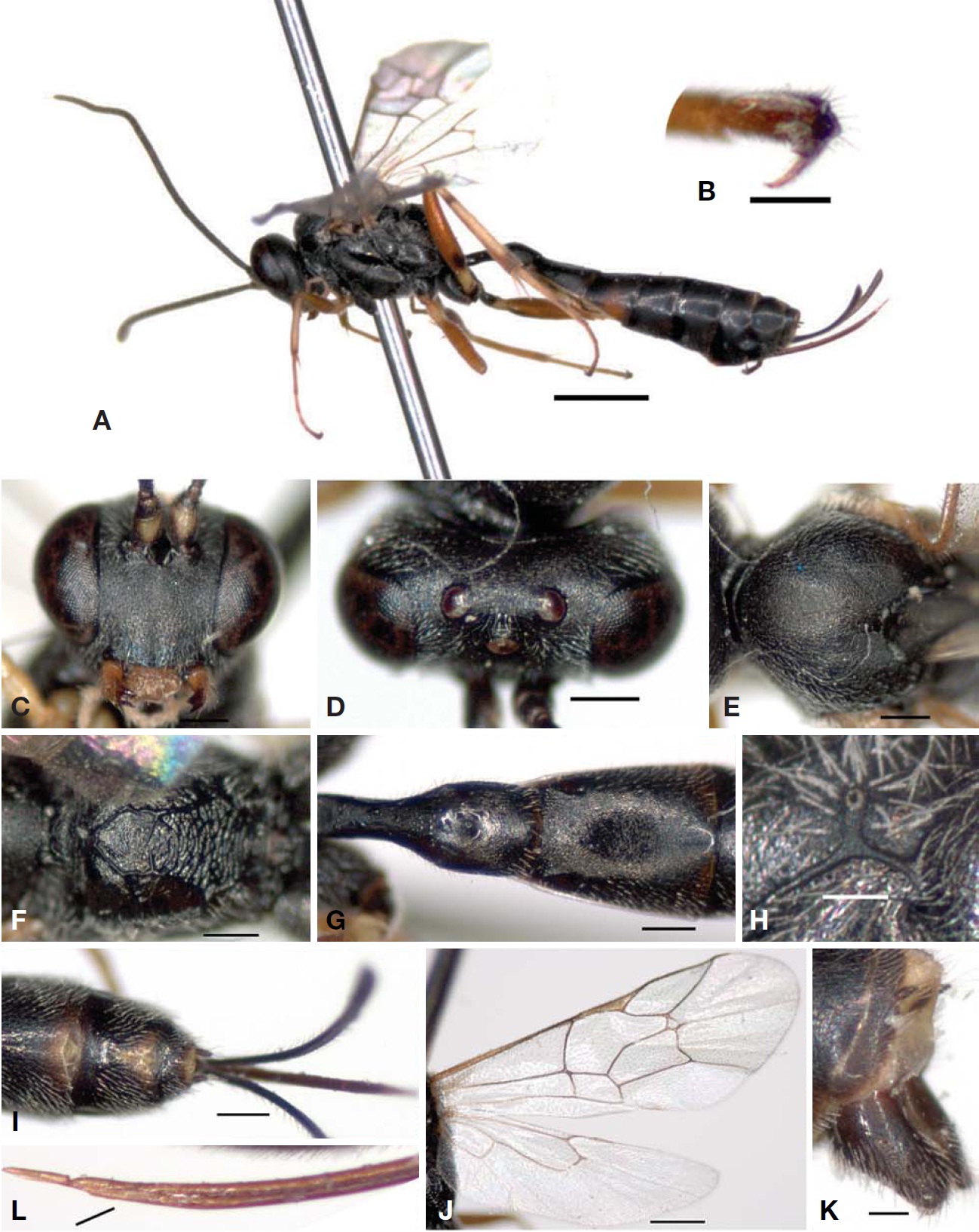



The subfamily Campopleginae, was first described by Forster in 1869 based on the genus
Most campoplegine species are specialized parasitoids of Lepidopteran or Coleopteran species, and many particularly attack most of the larvae of Lepidoptera as koinobiont endoparasitoids. The taxa of the genus
In this study, we found a newly recorded species,
The materials used in this study were collected from Jeju, Korea in 2009. The wasps were reared on
Specimens were picked from newly emerging females out of a mass rearing cage and examined by stereo microscopy (Zeiss Stemi SV 11 Apo; Carl Zeiss, Gottingen, Germany). The key characters are shown in photographs that were produced using a Delta imaging system (i-Delta 2.6; iMTechnology, Daejeon, Korea). Abbreviations are as follows: TD, type depository; NR, Naturhistoriska Riksmuseet, Sektionen for Entomologi, S-10405 Stockholm, Sweden; HU, Hokkaido University, Faculty of Agriculture, Entomological Institute, Sapporo, Japan; GUPTA, Entomology & Nematology Department, University of Florida, Gainesville, FL, USA (V.K. Gupta collection.).
Order Hymenoptera
Family Ichneumonidae
Genus Diadegma Forster, 1869
Diagnosis. Clypeus moderately convex, its apical margin truncate or weakly convex; lower tooth of mandible equal to upper tooth; genal carina join oral carina; areola longer than wide, areola and petiolar areas usually not separated from transverse carina; tarsal claws pectinate or sometimes pectinate only at the base; discoidella not reaching nervellus; ovipositor more than 2 times as long as apical depth of metasoma but sometimes only as long as apical depth of metasoma, strongly upcurved.
1*Diadegma fenestrale (Holmgren, 1860)
Material examined. [Lectotype] 1♀
, 147♂♂ 9♀♀, Korea: Jeju-do, Seogwipo-si, Daejeong-eup, Sangmo-ri, 28 May 2009, Kim JI, reared from
Description (female). Body length 5.5-6 mm. Fore wing length 3.5-4 mm. Antenna with 24 flagellomeres.
Color: Head black; mandible brown except apical part black; labrum brown; palpi yellow; scape mostly black, ventral part yellow; antenna black. Mososoma black; tegula pale brown; fore coxa black basally, yellow apically; fore trochanter and trochantellus pale yellow; femur, tibia, and tarsus brown; mid trochanter and trochantellus yellow, femur, tibia, and tarsus brown; hind coxa and trochanter black, trochantellus yellow; femur brown with black spot basally; tibia brown except for pale yellow dorsally with black spots apically and basally; tarsus yellowish brown. Ovipositor brown; ovipositor sheath black; third tergite reddish brown laterally.
Head: Face and frons finely punctate, frons without median vertical ridge; vertex closely and finely punctate more than face; occiput flat, at the edges like the profile of a dish, occipital carina complete; temple finely punctate and weakly convex; clypeus broad and rounded, weakly cancave, not separated from face, clypeal foveae open; mandible short and stout, upper tooth longer than lower; labial palp with four segments, maxillary palp with five segments; inner margins of eyes parallel; ocelli small.
Mesosoma: Pronotum subpolished, upper area with transverse stripe carinae, epomia absent; mesoscutum finely punctate, notauli absent (Fig. 1E); mesopleurum closely punctate and polished, trans-striate; prepectal carina and postpectal carinae complete, sternaulus weakly present basally; speculum convex and shiny, pleural pit strong; scutellum convex, closely punctate, lateral carina absent, postscutellum convex, wide longer than high; metapleurum finely punctate; propodeum with numerous transverse carina, basal area and areola separated by anterior transverse carina, areola and petiolar area incompletely separated, costula complete, petiolar area flat, with transverse carinae (Fig. 1F); spiracle of propodeum a small circle, connected to pleural carina (Fig. 1H); tarsal claw simple (Fig. 1B); fore wing with areolet, second intercubitus opened, basal vein based to nurvulus; second recurrent vein and discocubitus with each other 1 bulla; hind wing with four hamuli, intercubitella with one bulla, nervellus not intercepted, discoidella absent (Fig. 1J).
Metasoma: Slender; petiole with lateral pit; thyridium weak; glymma present; ovipositor upcurved, ovipositor sheath with hairs; middle of seventh sternite cut (Fig. 1I).
Male. Third to fifth tergites reddish brown laterally; thyridium reddish brown; middle of seventh sternite not cut.
Distribution. Korea (new record), Afghanistan, Austria, Azerbaijan,
Belgium, Bulgaria, Cyprus, Czech Republic, Czechoslovakia, Denmark, Finland, France, Germany, Hungary, Iceland, India, Ireland, Israel, Italy, Japan, Kazakhstan, Latvia, Lithuania, Moldova, Morocco, Netherlands, New Zealand, Norway, Pakistan, Philippines, Poland, Portugal, Romania, Russia, Spain, Sri Lanka, Sweden, Switzerland, Turkey, Turkmenistan, Ukraine, United Kingdom, and Yugoslavia.
Region. Eastern Palaearctic, Oceanic, Oriental, Western Palaearctic.
Remarks. This species was reared from
Korean name: 1*감자뿔나방살이자루맵시벌(신칭)
